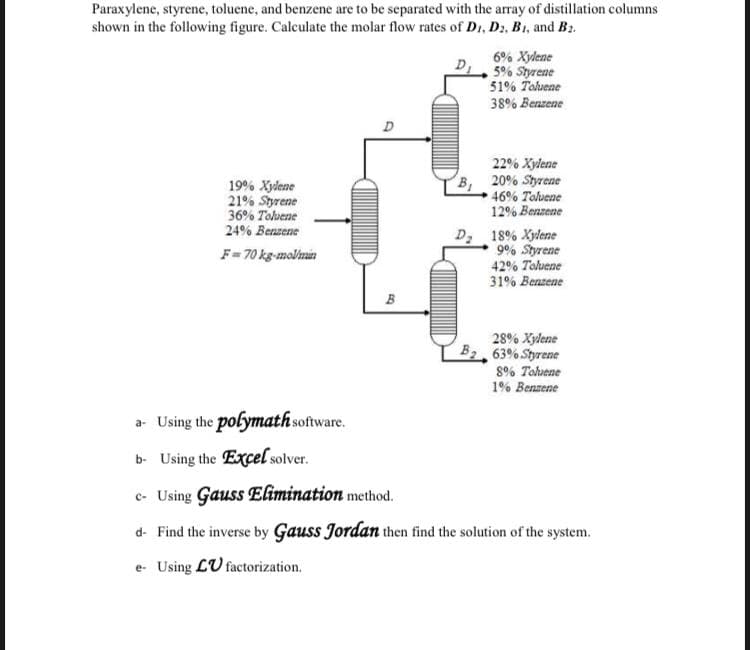Paraxylene, styrene, toluene, and benzene are to be separated with the array of distillation columns shown in the following figure. Calculate the molar flow rates of Di, D2, B1, and B2. 6% Xylene 5% Styrene 51% Toluene 38% Benzene 19% Xylene 21% Styrene 36% Tolvene 24% Berazene 22% Xylene B, 20% Shyrene 46% Tohuene 12% Benzene D, 18% Xylene 9% Styrene 42% Tohene 31% Benzene F= 70 kg-molmin B 28% Xylene 63% Styrene 8% Tohene 1% Benzene a- Using the polymath software. b- Using the Excel solver. c- Using Gauss Elimination method. d- Find the inverse by Gauss Jordan then find the solution of the system. e- Using LU factorization.
Paraxylene, styrene, toluene, and benzene are to be separated with the array of distillation columns shown in the following figure. Calculate the molar flow rates of Di, D2, B1, and B2. 6% Xylene 5% Styrene 51% Toluene 38% Benzene 19% Xylene 21% Styrene 36% Tolvene 24% Berazene 22% Xylene B, 20% Shyrene 46% Tohuene 12% Benzene D, 18% Xylene 9% Styrene 42% Tohene 31% Benzene F= 70 kg-molmin B 28% Xylene 63% Styrene 8% Tohene 1% Benzene a- Using the polymath software. b- Using the Excel solver. c- Using Gauss Elimination method. d- Find the inverse by Gauss Jordan then find the solution of the system. e- Using LU factorization.
Chapter14: Chromatography
Section: Chapter Questions
Problem 9P
Related questions
Question

Transcribed Image Text:Paraxylene, styrene, toluene, and benzene are to be separated with the array of distillation columns
shown in the following figure. Calculate the molar flow rates of D1, D2, B1, and B2.
6% Xylane
5% Styrene
51% Toluene
38% Benzene
19% Xylene
21% Styrene
36% Tolvene
24% Berazene
22% Xylene
B, 20% Styrene
46% Tohvene
12% Benzene
D, 18% Xylene
9% Styrene
42% Tohene
31% Benzene
F= 70 kg-molimin
B
28% Xylene
63% Styrene
8% Tohuene
1% Benzene
a- Using the polymath software.
b- Using the Excel solver.
c- Using Gauss Elimination method.
d- Find the inverse by Gauss Jordan then find the solution of the system.
e- Using LU factorization.
Expert Solution
This question has been solved!
Explore an expertly crafted, step-by-step solution for a thorough understanding of key concepts.
This is a popular solution!
Trending now
This is a popular solution!
Step by step
Solved in 3 steps

Knowledge Booster
Learn more about
Need a deep-dive on the concept behind this application? Look no further. Learn more about this topic, chemistry and related others by exploring similar questions and additional content below.Recommended textbooks for you


Principles of Instrumental Analysis
Chemistry
ISBN:
9781305577213
Author:
Douglas A. Skoog, F. James Holler, Stanley R. Crouch
Publisher:
Cengage Learning

EBK A SMALL SCALE APPROACH TO ORGANIC L
Chemistry
ISBN:
9781305446021
Author:
Lampman
Publisher:
CENGAGE LEARNING - CONSIGNMENT


Principles of Instrumental Analysis
Chemistry
ISBN:
9781305577213
Author:
Douglas A. Skoog, F. James Holler, Stanley R. Crouch
Publisher:
Cengage Learning

EBK A SMALL SCALE APPROACH TO ORGANIC L
Chemistry
ISBN:
9781305446021
Author:
Lampman
Publisher:
CENGAGE LEARNING - CONSIGNMENT